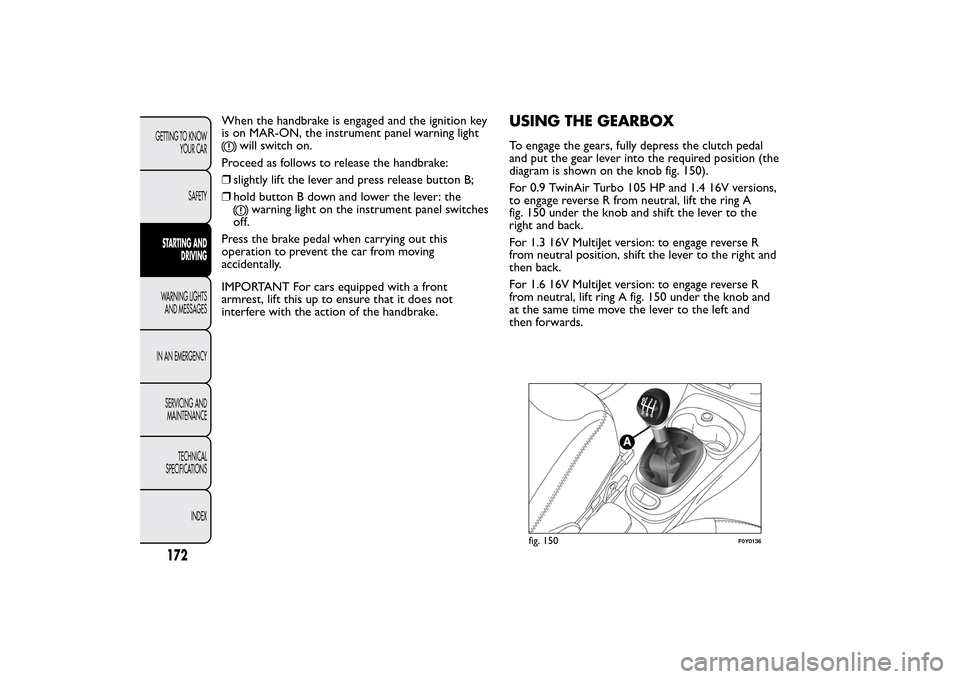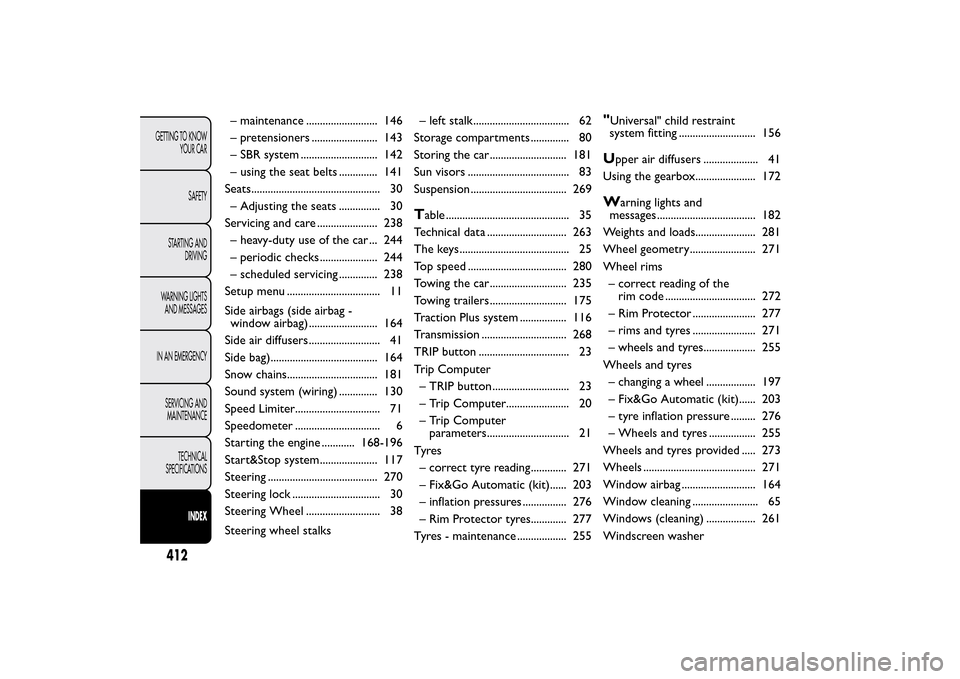2014 FIAT 500L LIVING Using the gearbox
[x] Cancel search: Using the gearboxPage 176 of 420

When the handbrake is engaged and the ignition key
is on MAR-ON, the instrument panel warning light
will switch on.
Proceed as follows to release the handbrake:
❒slightly lift the lever and press release button B;
❒hold button B down and lower the lever: the
warning light on the instrument panel switches
off.
Press the brake pedal when carrying out this
operation to prevent the car from moving
accidentally.
IMPORTANT For cars equipped with a front
armrest, lift this up to ensure that it does not
interfere with the action of the handbrake.
USING THE GEARBOXTo engage the gears, fully depress the clutch pedal
and put the gear lever into the required position (the
diagram is shown on the knob fig. 150).
For 0.9 TwinAir Turbo 105 HP and 1.4 16V versions,
to engage reverse R from neutral, lift the ring A
fig. 150 under the knob and shift the lever to the
right and back.
For 1.3 16V MultiJet version: to engage reverse R
from neutral position, shift the lever to the right and
then back.
For 1.6 16V MultiJet version: to engage reverse R
from neutral, lift ring A fig. 150 under the knob and
at the same time move the lever to the left and
then forwards.
fig. 150
F0Y0136
172GETTING TO KNOW
YOUR CAR
SAFETYSTARTING AND
DRIVINGWARNING LIGHTS
AND MESSAGES
IN AN EMERGENCY
SERVICING AND
MAINTENANCE
TECHNICAL
SPECIFICATIONS
INDEX
Page 200 of 420

IN AN EMERGENCY
In an emergency we recommend that you call the free-phone number found on the Warranty
Booklet.You can also go to the www.fiat.com website to find your nearest Fiat Dealership.STARTING THE ENGINEContact to a Fiat Dealership immediately if
instrument panel warning light
comes on
constantly.
JUMP STARTING
If the battery is flat, the engine may be started using
an auxiliary battery with the same capacity or a
little higher than the flat one.Proceed as follows to start the car:
❒connect the positive terminals (+near the
terminal) of the two batteries with a jump lead
fig. 153;
❒with a second lead, connect the negative terminal
–of the auxiliary battery to an earth point
on
the engine or the gearbox of the car to be started;
❒start the engine;
❒when the engine has been started, remove the
leads reversing the order above.
For versions with Start&Stop system, to carry out
the jump starting procedure, refer to the paragraph
“Start&Stop system” in the “Getting to know your
car” section.
If after a few attempts the engine does not start, do
not persist but contact a Fiat Dealership.
IMPORTANT Do not directly connect the negative
terminals of the two batteries: sparks could ignite
explosive gas released from the battery. If the
auxiliary battery is installed on another car, prevent
accidental contact between metallic parts of the two
cars.
fig. 153
F0Y0137
196GETTING TO KNOW
YOUR CAR
SAFETY
STARTING AND
DRIVING
WARNING LIGHTS
AND MESSAGES
IN AN
EMERGENCY
SERVICING AND
MAINTENANCE
TECHNICAL
SPECIFICATIONS
INDEX
Page 383 of 420

CLOCK
Press the "Clock" button (see fig. 13) to display the
clock.
eco:Drive
The eco:Drive application (fig. 14) allows the driver
to monitor their driving style in order to achieve
more efficient driving in terms of fuel economy and
emissions reduction.
Monitoring appears on the display in real time; it is
however possible to access detailed overall
information by consulting the eco:Drive site (see
paragraph "Data transfer").
The assessment of driving style is indicated by 4
indices which are assessed as optimal when the
"eco"-driving style criteria below are complied with:❒Acceleration/Deceleration: avoid abrupt
acceleration/deceleration, favouring gradual
increases/decreases in speed.
❒Gearbox: use the gear most suited to the road
conditions, in order to optimise fuel consumption
(on versions with automatic transmission, using
"Auto" mode, this parameter is not displayed).
❒Speed: adopt a driving style which maintains, above
all on traffic-free roads, the most appropriate,
constant driving speed, anticipating any
deceleration due to uneven road surfaces or traffic
conditions.
NOTES
The values measured are not directly connected to
instant fuel consumption but are intended to suggest
how the driver can alter their driving style in order
to reduce consumption.
Different journeys may have different values even
though the driver maintains the same driving style,
since they are affected by factors such as traffic
conditions, length of journey and cold starting.
An "eco:Drive" is a more "fluid" drive, even if traffic
conditions often inhibit this. A more "aggressive"
drive, on the other hand, implies frequent
acceleration/deceleration with resulting increased fuel
consumption and harmful emissions.
fig. 14
F0Y1014
379
Page 416 of 420

– maintenance .......................... 146
– pretensioners ........................ 143
– SBR system ............................ 142
– using the seat belts .............. 141
Seats............................................... 30
– Adjusting the seats ............... 30
Servicing and care ...................... 238
– heavy-duty use of the car ... 244
– periodic checks ..................... 244
– scheduled servicing .............. 238
Setup menu .................................. 11
Side airbags (side airbag -
window airbag) ......................... 164
Side air diffusers .......................... 41
Side bag)....................................... 164
Snow chains................................. 181
Sound system (wiring) .............. 130
Speed Limiter............................... 71
Speedometer ............................... 6
Starting the engine ............ 168-196
Start&Stop system..................... 117
Steering ........................................ 270
Steering lock ................................ 30
Steering Wheel ........................... 38
Steering wheel stalks– left stalk................................... 62
Storage compartments .............. 80
Storing the car ............................ 181
Sun visors ..................................... 83
Suspension ................................... 269
Table ............................................. 35
Technical data ............................. 263
The keys ........................................ 25
Top speed .................................... 280
Towing the car............................ 235
Towing trailers ............................ 175
Traction Plus system ................. 116
Transmission ............................... 268
TRIP button ................................. 23
Trip Computer
– TRIP button ............................ 23
– Trip Computer....................... 20
– Trip Computer
parameters.............................. 21
Tyres
– correct tyre reading............. 271
– Fix&Go Automatic (kit)...... 203
– inflation pressures ................ 276
– Rim Protector tyres............. 277
Tyres - maintenance .................. 255
"Universal" child restraint
system fitting ............................ 156U
pper air diffusers .................... 41
Using the gearbox...................... 172
W
arning lights and
messages .................................... 182
Weights and loads...................... 281
Wheel geometry........................ 271
Wheel rims
– correct reading of the
rim code ................................. 272
– Rim Protector ....................... 277
– rims and tyres ....................... 271
– wheels and tyres................... 255
Wheels and tyres
– changing a wheel .................. 197
– Fix&Go Automatic (kit)...... 203
– tyre inflation pressure ......... 276
– Wheels and tyres ................. 255
Wheels and tyres provided ..... 273
Wheels ......................................... 271
Window airbag ........................... 164
Window cleaning ........................ 65
Windows (cleaning) .................. 261
Windscreen washer
412GETTING TO KNOW
YOUR CAR
SAFETY
STARTING AND
DRIVING
WARNING LIGHTS
AND MESSAGES
IN AN EMERGENCY
SERVICING AND
MAINTENANCE
TECHNICAL
SPECIFICATIONS
INDEX